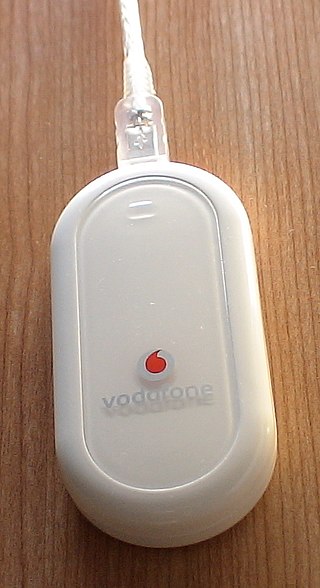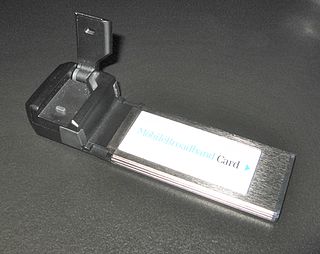
3G is the third generation of wireless mobile telecommunications technology. It is the upgrade over 2G, 2.5G, GPRS and 2.75G Enhanced Data Rates for GSM Evolution networks, offering faster data transfer, and better voice quality. This network was superseded by 4G, and later on by 5G. This network is based on a set of standards used for mobile devices and mobile telecommunications use services and networks that comply with the International Mobile Telecommunications-2000 (IMT-2000) specifications by the International Telecommunication Union. 3G finds application in wireless voice telephony, mobile Internet access, fixed wireless Internet access, video calls and mobile TV.
4G is the fourth generation of broadband cellular network technology, succeeding 3G and preceding 5G. A 4G system must provide capabilities defined by ITU in IMT Advanced. Potential and current applications include amended mobile web access, IP telephony, gaming services, high-definition mobile TV, video conferencing, and 3D television.

StarHub Limited, commonly known as Starhub, is a Singaporean multinational telecommunications conglomerate and one of the major telcos operating in the country. Founded in 1998, it is listed on the Singapore Exchange (SGX).
Xfera Móviles, S.A.U., d/b/a Yoigo, is the fourth-largest mobile network operator in Spain and a subsidiary of the Spanish telecommunications company Grupo MásMóvil. Yoigo has a licence and its own cellular network for GSM/2G, UMTS/3G and LTE/4G technologies, and a national roaming agreement for usage of the 2G, 3G and 4G networks of Orange and Movistar.

SiRF Technology, Inc. was a pioneer in the commercial use of GPS technology for consumer applications. The company was founded in 1995 and was headquartered in San Jose, California. Notable and founding members included Sanjai Kohli, Dado Banatao, and Kanwar Chadha. The company was acquired by British firm CSR plc in 2009, who were in turn subsequently acquired by American company Qualcomm on 13 August 2015.

Vodafone Mobile Connect USB Modem branded as Vodem is a product of Vodafone that connects to the broadband internet. It is connected to the computer via USB which makes the product usable to virtually any computer, desktop or laptop.

High Speed Packet Access (HSPA) is an amalgamation of two mobile protocols—High Speed Downlink Packet Access (HSDPA) and High Speed Uplink Packet Access (HSUPA)—that extends and improves the performance of existing 3G mobile telecommunication networks using the WCDMA protocols. A further-improved 3GPP standard called Evolved High Speed Packet Access was released late in 2008, with subsequent worldwide adoption beginning in 2010. The newer standard allows bit rates to reach as high as 337 Mbit/s in the downlink and 34 Mbit/s in the uplink; however, these speeds are rarely achieved in practice.

Mobile broadband is the marketing term for wireless Internet access via mobile networks. Access to the network can be made through a portable modem, wireless modem, or a tablet/smartphone or other mobile device. The first wireless Internet access became available in 1991 as part of the second generation (2G) of mobile phone technology. Higher speeds became available in 2001 and 2006 as part of the third (3G) and fourth (4G) generations. In 2011, 90% of the world's population lived in areas with 2G coverage, while 45% lived in areas with 2G and 3G coverage. Mobile broadband uses the spectrum of 225 MHz to 3700 MHz.

The Huawei E220 is a Huawei HSDPA access device (modem) manufactured by Huawei and notable for using the USB interface.
UNISOC, formerly Spreadtrum Communications, Inc., is a Chinese fabless semiconductor company headquartered in Shanghai which produces chipsets for mobile phones. UNISOC develops its business in two major fields - consumer electronics and industrial electronics, including smartphones, feature phones, smart audio systems, smart wear and other application fields; Industrial electronics cover the fields such as LAN IoT, WAN IoT and smart display.
In telecommunications, long-term evolution (LTE) is a standard for wireless broadband communication for mobile devices and data terminals, based on the GSM/EDGE and UMTS/HSPA standards. It improves on those standards' capacity and speed by using a different radio interface and core network improvements. LTE is the upgrade path for carriers with both GSM/UMTS networks and CDMA2000 networks. Because LTE frequencies and bands differ from country to country, only multi-band phones can use LTE in all countries where it is supported.
ST-Ericsson was a multinational manufacturer of wireless products and semiconductors, supplying to mobile device manufacturers. ST-Ericsson was a 50/50 joint venture of Ericsson and STMicroelectronics established on 3 February 2009 and dissolved 2 August 2013. Headquartered in Geneva, Switzerland, it was a fabless company, outsourcing semiconductor manufacturing to foundry companies.

A mobile broadband modem, also known as wireless modem or cellular modem, is a type of modem that allows a personal computer or a router to receive wireless Internet access via a mobile broadband connection instead of using telephone or cable television lines. A mobile Internet user can connect using a wireless modem to a wireless Internet Service Provider (ISP) to get Internet access.
Sony Semiconductor Israel Ltd., formerly known as Altair Semiconductor, is an Israeli developer of high performance single-mode Long Term Evolution (LTE) chipsets. The company's product portfolio includes baseband processors, RF transceivers and a range of reference hardware products. Founded in 2005, Altair employs 190 employees in its Hod Hasharon, Israel headquarters and R&D center, and has regional offices in the United States, Japan, China, India, Finland, and France. Altair Semiconductor was the first chipset vendor to receive certification from Verizon Wireless to run on its 4G LTE network. Altair has also powered several devices launched on Verizon's network including the Ellipsis 7 tablet and HP Chromebook 11.6"LTE. In January 2016, it was announced that Sony was acquiring Altair for $212 Million. Altair was renamed Sony Semiconductor Israel on March 29, 2020.

Qualcomm Gobi is a family of embedded mobile broadband modem products by Qualcomm. Gobi technology 2 was designed to allow for any product with the embedded solution to connect to the internet anywhere a wireless carrier provides data coverage. One of the more notable products that contain a Gobi modem is the iPhone 4 for Verizon, which contains a MDM6600, however it does not take advantage of the support for HSPA+.
Intel Mobile Communications (IMC), is the mobile research and development division of Intel. It was formed when Intel completed the acquisition of the Wireless Solutions (WLS) division of Infineon early in 2011 for US$1.4 billion. The Infineon subsidiary Comneon was also acquired by Intel and integrated into Intel Mobile Communications. IMC maintained offices in Munich from the Comneon deal under Intel Mobile Communications GmbH. Some other offices in Germany were closed in 2015.
The E5 is a mobile Wi-Fi device produced by Huawei Technologies, and is part of the company's mobile Wi-Fi series that includes the E5830s, E585, E583c and E586. The E5 series connect to other devices using a wireless interface. The devices are pocket size and allow users to access the Internet through any Wi-Fi device, mobile phone, game console, digital camera, notebook and personal digital assistant (PDA).
AirHop Communications is a privately funded American corporation based in San Diego, CA. AirHop develops radio access network (RAN) software that addresses the installation, operation and performance challenges of multi-layer deployments of small cells in 3G and 4G networks. AirHop's customers are typically base station equipment vendors for wireless network operators.
3G mobile telephony was relatively slow to be adopted globally. In some instances, 3G networks do not use the same radio frequencies as 2G so mobile operators must build entirely new networks and license entirely new frequencies, especially so to achieve high data transmission rates. Other delays were due to the expenses of upgrading transmission hardware, especially for UMTS, whose deployment required the replacement of most broadcast towers. Due to these issues and difficulties with deployment, many carriers delayed acquisition of these updated capabilities.









